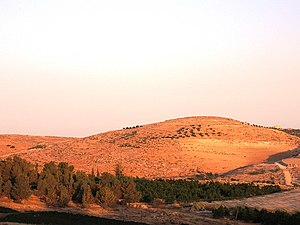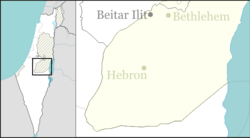Horvat Maon/Horvat Ma'on,[1][2] Arabic: Khirbet Ma'in[3][4] or Tell Máîn (SWP map No. 25), is an archaeological site in the Hebron Hills, West Bank, rising 863 metres (2,831 ft) above sea level, where the remains of the ancient town of Ma'on (Hebrew: מעון) have been excavated. The town, now a ruin, is mentioned in the Book of Joshua[5] and the Books of Samuel.[6] It still had a Jewish population during the Roman and Byzantine periods, and a synagogue was discovered there. The site was ultimately abandoned around the time of the Muslim conquest.[7]
Horvat Ma'on
| |
|---|---|
Ruin | |
 Horvat Ma'on near Hebron | |
| Coordinates: 31°24′34″N 35°08′02″E / 31.40944°N 35.13389°E | |
| Grid position | 162/090 PAL |
| Region | West Bank |
| District | Judea and Samaria Area |
| Government | |
| • Council | Har Hevron (Mount Hebron) Regional Council |
| Time zone | UTC+2 (IST) |
| • Summer (DST) | UTC+3 (IDT) |
The site is located about 6 kilometres (3.7 mi) southeast of Yatta. Immediately to the north lies the modern small village of Ma'in.
Etymology
editThe Hebrew name is variously spelled as Horvat Ma'on,[2] Horvat Maon,[1] or Hurbat Ma'on. Tel Ma'on is sometimes also used.[8]
The Hebrew word ma'on means 'dwelling', 'habitation'.[9]
Horvat, horbat, hurbat, hurvat are transliteration variants of the Hebrew word for 'ruins' and direct equivalents of the Arabic khirbet. Tell is the transliteration of the Arabic word, tel of the Hebrew one, both meaning mound created by accumulation of settlement layers.
In ancient sources
editHebrew Bible
editThe site is first mentioned as one of the cities of Judah.[10][11] Maon was the place of birth of Nabal the Carmelite.[12] In the Book of Samuel,[13] "the wilderness of Maon" is mentioned as a place of refuge for David when he fled from king Saul.[10] The site is not referred to again in biblical sources.[10]
Late Roman (?) and Early Byzantine period
editAfter the destruction of the Second Temple, there is again a reference to the site, when Rabban Yohanan ben Zakkai is said to have gone up to Maon of Judah.[10][14]
In the early 4th century CE, Maon was mentioned in Eusebius' Onomasticon as being "in the tribe of Judah; in the east of Daroma."[15] During the Late Roman-Early Byzantine period, Darom or Daroma (Hebrew and Aramaic for "South") became a term used for the southern Hebron Hills in rabbinic literature and in Eusebius' Onomasticon.[16][15] At the time, the Hebron Hills were demographically separated into two distinct districts, with only the southern one retaining a Jewish population along with a newer, Christian one.[17] The site was eventually abandoned around the time of the Muslim conquest.[7]
Archaeology
editOccupation periods
editArchaeologists have discovered at the site potsherds dating back to the Early Bronze Age, the Iron Age (Israelite period) including jar handles bearing the palaeo-Hebrew inscription LMLK, 'for the king', and from the Hellenistic period.[10] Sherds have also been found in situ from the Roman and Byzantine periods, as well as from the Middle Ages.[10] Wine and olive presses from the Roman and Byzantine periods were discovered on the west slope of the tell.[18] The ancient synagogue of Ma'on is dated to the Byzantune period (see below).[18] The absence of material traces from the late 7th-early 8th century are an indication of the abandonement of the village at that time.[18]
Byzantine-period synagogue
editA synagogue dating back to the Byzantine/Talmudic period was discovered at Hurvat (Horbat) Ma'on.[19] Two occupation phases were discerned, covering the 4th/5th through the 7th century.[18]
19th-century observations
editC.R. Conder of the Palestine Exploration Fund visited the site in 1874,[20] during which time a brief description was written of the site:
Tell Maʻîn –– A mound some 100 feet high. On the west are foundations, caves, and cisterns, and foundations of a tower about 20 feet square. The masonry in this tower is large, with a broad irregular draft and a rustic boss. One stone was 3 feet 8 inches long, 2 feet 9 inches high, the draft about 3 inches wide. There is also a round well-mouth, 5 feet diameter, cut out of a single stone.[21]
Modern era
editHorbat Maon is situated SE of the Arab town of Yatta, on the north side of regional highway 317. By the 1970s, a few Arab families from Yatta had settled on the northern slope of the tell, who work in subsistence farming and graze their flocks of sheep.[22]
Further reading
edit- Ilan, Z. [in Hebrew] (1988). "Maon - A Synagogue from the period of the Talmud (מעון - בית כנסת מתקופת התלמוד)". Sela'it - A Monthly Magazine for the Youth (in Hebrew). 17 (2). Tel-Aviv: The Society for the Protection of Nature: 16–17. ISSN 0334-4479.
- Ilan, Z. [in Hebrew] (1991). Ancient Synagogues in Erez Israel (בתי כנסת קדומים בארץ ישראל). Tel-Aviv: Miśrad ha-biṭaḥon. ISBN 9650505229. OCLC 26159213.
- Amit, David (2003). Synagogues at Tell Maon and at Tell 'Anim, and the Jewish settlement in the south of Mount Hebron (בתי הכנסת בחורבת מעון ובחורבת ענים והיישוב היהודי בדרום הר חברון). Jerusalem: Hebrew University (Doctoral dissertation). OCLC 170885342.
Gallery
edit-
The ancient hill of Tel Ma'on,[which?] South Hebron Hills
-
Tel/Horvat Ma'on near Hebron
-
Stone troughs at the well of Ma'on
-
Staircase
-
Ancient remains
-
Ancient structures
-
Ancient wall
-
Remnants of Byzantine fort at Horvat Ma'on
-
Detail
-
Ancient stones
See also
edit- Ancient synagogues in the Palestine region - covers entire Palestine region/Land of Israel
- Ancient synagogues in Israel - covers the modern State of Israel
- Ma'in, Hebron, small village located just north of the site
- Ma'on, Mount Hebron, Israeli settlement, c. 3 km east of the ancient site
References
edit- ^ a b Amit, David (1998). "Architectural Plans of Synagogues in the Southern Judean Hills and the 'Halakah'". In Dan Urman; Paul Virgil McCracken Flesher (eds.). Ancient Synagogues: Historical Analysis and Archaeological Discovery. Studia Post Biblica (47)/Themes in Biblical Narrative (47). BRILL. p. 130. ISBN 9004112545. Retrieved 8 February 2024.130]
- ^ a b Vlada Nikolsky (07/07/2010). "Horbat Ma‘on: Final Report". In HA-ESI Volume 122 (2010). Accessed 8 Feb 2024.
- ^ Tsafrir, Y.; Leah Di Segni; Judith Green (1994). (TIR): Tabula Imperii Romani. Iudaea, Palestina: Eretz Israel in the Hellenistic , Roman and Byzantine Periods; Maps and Gazetteer. Jerusalem: Israel Academy of Sciences and Humanities. p. 178. ISBN 965-208-107-8.
- ^ Aharoni, Y. (1979). The Land of the Bible: A Historical Geography (2 ed.). Philadelphia: Westminster Press. p. 439. ISBN 0664242669. OCLC 6250553. (original Hebrew edition: 'Land of Israel in Biblical Times - Historical Geography', Bialik Institute, Jerusalem (1962))
- ^ Joshua 15:55
- ^ 1 Samuel 25:2
- ^ a b Ehrlich, Michael (2022-05-31), "Judea and Jerusalem", The Islamization of the Holy Land, 634–1800, ARC Humanities Press, pp. 117–118, doi:10.1515/9781802700312-007, ISBN 978-1-80270-031-2, retrieved 2024-09-19
- ^ David Amit page at IAA website. Accessed 8 Feb 2024.
- ^ "maon or main" (entry 4583). Strong's Concordance, accessed 8 Feb 2024 via Bible Hub.
- ^ a b c d e f Amit (n.d.), pp. 222–223
- ^ Freedman (2000), p. 854
- ^ Guérin (1869), pp. 170–172
- ^ 1 Samuel 23:24–25
- ^ Mekhilta of Rabbi Ishmael on Exodus 19:1
- ^ a b Chapman & Taylor (2003), p. 72.
- ^ Baruch, Yuval (2009). חורבת סוסיה ורוג'ם אל-חמירי כמקרי מבחן להתפתחותו של הכפר והיישוב הכפרי בדרום הר-חברון מן התקופה הרומית הקדומה ועד לתקופה המוסלמית הקדומה [Horbat Susya and Rujum el-Hamiri as a Case-Study for the Development of the Village and the Rural Settlement in the Southern Hebron Hills from the Early Roman to the Early Muslim Periods] (in Hebrew). Hebrew University of Jerusalem. OCLC 646899358.
- ^ Avni, Gideon (2014). The Byzantine-Islamic transition in Palestine: an archaeological approach. Oxford University Press. pp. 197, 254–255. ISBN 978-0-19-150734-2. OCLC 871044531.
- ^ a b c d Magness, Jodi (2003). The Archaeology of the Early Islamic Settlement in Palestine. Eisenbrauns, Vol.1, pp. 96–97. Accessed 8 Feb 2024.
- ^ Amit (1997), p. 155
- ^ Conder (1879), pp. 90–91
- ^ Conder & Kitchener (1883), p. 415
- ^ Amit (n.d.), p. 223
Bibliography
edit- Al-Muqaddasi (1994). The Best Divisions for Knowledge of the Regions. Translated by Basil Anthony Collins. Reading: Garnet Publishing. ISBN 1-873938-14-4.
- Amit, David (n.d.). "Hurvat Ma'on". In Ben-Yosef, Sefi (ed.). Israel Guide - Judaea (A useful encyclopedia for the knowledge of the country) (in Hebrew). Vol. 9. Jerusalem: Keter Publishing House, in affiliation with the Israel Ministry of Defence. OCLC 745203905.
{{cite book}}: CS1 maint: year (link) - Amit, David (1997), "A marble candelabrum from the synagogue of Maon in Judea", Judea and Samaria Research Studies (מחקרי יהודה ושומרון) (PDF) (in Hebrew), vol. 7, Jerusalem: Israel Antiquities Authority, OCLC 741089250
- Chapman III, Rupert L.; Taylor, J.E., eds. (2003). Palestine in the Fourth Century A.D.: The Onomasticon by Eusebius of Caesarea. Translated by G.S.P. Freeman-Grenville. Jerusalem: Carta. p. 72. ISBN 965-220-500-1. OCLC 937002750.
- Conder, C.R. (1879). Tent Work in Palestine. A Record of Discovery and Adventure. Vol. 2. London: Richard Bentley & Son (published for the Committee of the PEF). OCLC 23589738.
- Conder, C.R.; Kitchener, H.H. (1883). The Survey of Western Palestine: Memoirs of the Topography, Orography, Hydrography, and Archaeology. Vol. 3. London: Committee of the Palestine Exploration Fund.
- Freedman, D.N.; Allen C. Myers (31 December 2000). Eerdmans Dictionary of the Bible. Amsterdam University Press. ISBN 978-90-5356-503-2.
- Guérin, Victor (1869). Description Géographique Historique et Archéologique de la Palestine (in French). Vol. 1: Judée, pt. 3. Paris: L'Imprimerie impériale.
External links
edit- Survey of Western Palestine, Map 25: IAA, Wikimedia commons (Tell Máîn shown on upper part of map)
